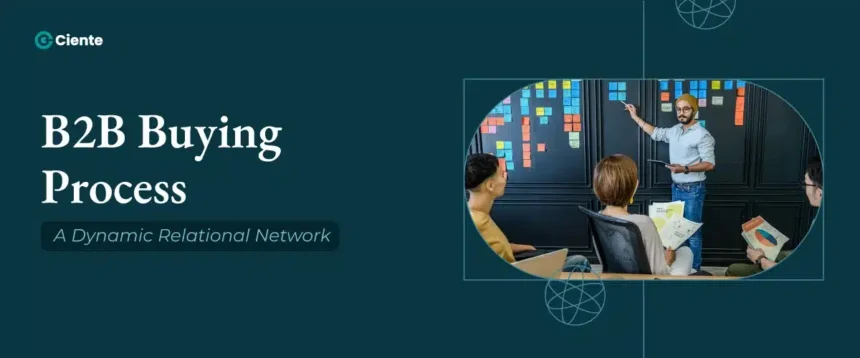Popular frameworks underline the B2B buying process as linear. But in reality, it’s a nexus shaped by social dynamics, risks, and unknown variables.
Transparent wants and impulses drive a majority of B2C purchases.
But B2B buying is on a whole new tangent. It stems from multiple data points, risk evaluations, and a tangled web of relationships, often driven by internal politics.
The B2B buying process isn’t the linear and structured system you imagine it to be. It’s rarely even a system or a process, at least in the traditional sense. If organizational decision-making were this orderly, customer journey mapping might not require much precision and nuance.
And most marketers have come to recognize this.
The reality is far messier, complex, and dynamic. Rather than a line or a funnel, imagine the B2B buying journey as a network where invisible and hierarchical communications and influence flows intertwine.
Yet, marketing frameworks oversimplify these complexities. It’ll never be the single instantaneous act that most marketing lingo illustrates it to be.
This oversimplication isn’t harmless. But in the long term, it can hamper your strategy.
If you aren’t diving into who your buyers are, why they purchase, and how they arrive at decisions, you are working with half a picture.
What is the B2B Buying Process?
The B2B buying process refers to the overall decision-making that businesses embrace while purchasing a solution, from problem recognition to implementation.
However, it’s not a sequence of steps.
But a tug-of-war between alignment and conflict across and within the organization.
Every B2B purchase is an evolving negotiation, not just between buyers and sellers, but between internal decision-makers. And consensus isn’t only desired, it’s imperative.
The theoretical framework is the only known fact about the B2B buying process. But the factual and descriptive details are often overlooked.
So, to draw even the slightest cognizance, let’s draw a bigger picture – the four fundamental elements in B2B buying:
Problem recognition
You cannot spotlight the B2B buying process as an objective process. If you’re doing so, then you’re admonishing the buyer-seller relationships, i.e., interaction between people.
This is quite a subjective step.
Most often, even an organizational purchase wouldn’t stem from economic considerations. The purchase could be a response to a need or a problem. This is known as the buying situation.
The organization develops awareness for buying a solution. This is problem recognition – a dissatisfaction with the current goal attainment.
Because the currently leveraged infrastructure or methodologies are proving ineffective.
And this is what marketing puts to use.
Savvy marketers can motivate this organization – our solutions don’t just help you solve the problems. We help you amp up your goals for higher satisfaction.
Even your client organizations are under pressure to do better and deliver more value. So, they should be the ones with the motivation to do better (using your solutions). And if you, as a marketer, hit the right mark, you know it’s a done deal.
Problem recognition is simply the difference between the desired and actual level of goal attainment.
Buying authority
Purchase decisions are made by individuals within the organization.
And their level of authority over the decision-making process rests on several factors:
- The technical complexities
- How will the solution integrate with existing infrastructure?
- Its urgency (need) for the business
- Does the individual hold the necessary technical knowledge?
- The individual’s position in the buying committee
Mostly, the buying authority the individual possesses directly aligns with their organizational responsibility.
And generally, there’s a tug between market expertise and product expertise when it comes to making buying decisions. It’s often the case that market knowledge takes precedence over technical knowledge about the solutions.
This could birth conflict between the buying committee and the department that’s leveraging the solution. So, B2B buying processes tend to involve both market and product variables:
1. Market v/s product variables – which is prioritized? It depends on:
- Technical complexities of the solution
- Importance of the solution as opposed to the business’s overall functioning
- The number of alternative choices in the market
2. When does the buying committee hold more power?
- Market variables take precedence.
- Business starts to scale and enter fresher market territories.
3. When does the department (leveraging the solution) have a say?
- Product variables take precedence.
- The buying committee has less experience in purchasing and using the solution.
4. And as the purchase’s monetary value increases, stakeholders gain more control over the buying process.
Searching for the accurate solution
The B2B buying process involves evaluating available providers. And this requires collecting and analyzing information.
The main objectives are to identify what is available and what is lacking, and second, to outline alternate choices.
It begins with a comprehensive search process:
- Evaluating goals – is the organization satisfied with the current goals?
- Finding the best alternative option. But the search often stops when the value of information collection increases. The buyer would not have all the market information to find the best alternative option or the most optimal one in the market.
- Establishing preliminary evaluation criteria to shortlist the options. There are time constraints on the purchase. The buying committee must choose on the basis of the market information they’ve collected – selective perception.
- Outline a list of providers. Before the search for additional information stops, the organization must ascertain that a particular number of alternatives have been identified. This must include familiar alternatives to fresher ones.
But knowing where the limits lie in this search is the buying committee’s task. As complex as it becomes, the cost of collecting information rises, too.
Making the final choice
Buyers must choose between all the alternative options. And it involves three stages:
1. Provider qualification.
This depends on a credible rating, financial strength, management capabilities, size and quality of their organization, years in the market, quality control, and performance standards.
Some organizations take the safer road. They don’t opt for newer, untested providers due to the risk they pose, while some undergo qualification procedures.
2. Comparing the solution against the required specifications.
Here, the focus is on specific constraints, such as solution features, quality level, pricing models, and delivery time.
3. Comparing solutions against each other.
Choose among the alternatives to find one that meets all the stated specifications. And one that will offer the highest level of acceptable value to the buying organization.
These four aspects establish a simple framework for the B2B buying process.
Observably, it all boils down to what really matters to the buyers: service, quality, and price. These drive every nitty-gritty of B2B decision-making.
It might not offer a granular perspective into organizational decision-making. But sets the stage for marketers to respond efficiently to this buying process.
There are several variables involved. And even the slightest glimpse into the window might help marketing set the stage to better their deliverables and offerings.
The Interorganizational Relationships: Conflicts and Consensus
Stakeholders might share the same boardroom, but they don’t share the same urgency, need, or agenda. Given their differentiating position in the organization, this is a given.
Most often, they don’t even use the same vocabulary, which crucially impacts goal establishing.
Their understanding of success is distinct. And so is their threshold for risks.
This is where clarity really lacks.
Do you realize how many dyadic interactions a single buying committee would entail?
Both perspectives should be factored in: the interaction between the buying committee members and that with external figures (vendors, SDRs, etc.).
Most often, this isn’t even the complicated bit.
The decisions are driven by goal attainment, but constricted due to financial, infrastructural, or staffing insufficiency. However, it’s common across the marketplace.
What isn’t often paid attention to are the intricacies.
One of the vital influences on the B2B buying process is the organizational factor – on what basis does the buying committee decide?
The buying committee and its members
At the nucleus, the buying process involves 6 to 10 decision-makers who have varied roles and authority.
The purview? B2B decision-making is a multi-dimensional journey businesses undertake to evaluate, select, and purchase solutions from another organization. This makes it crucial to understand the foundation of those involved in the buying process.
The fundamental roles in a buying committee:
- Those who will leverage the solutions.
- Buyers with the formal responsibility and authority to make the buy.
- Influencing actors that directly or indirectly impact the decision.
- Decision-makers who have the authority to select between alternative options.
- Gatekeepers who control the budget, resource allocation, and information flow in and out of the buying committee.
Here, decisions not only converge but also collide. With multiple touchpoints (departments) that have a voice, the result is a contradictory and complex decision-making web.
This is what the B2B buying process ought to be. When the stakes are higher, every decision can have an impact. It affects the entire business, and that’s no joke.
So, B2B decision-making is slow-moving and collaborative, unlike B2C purchases. The buying committees hesitate, loop back, drop off, revisit competitor offerings, and restart.
It’s much more like navigating a maze instead of walking straight ahead. And there’s no neatness to this – it’s not a clear funnel, but a messy intertwining of wires that represents a personal set of interactions, power struggles, and progress loops.
How can marketing navigate this complexity?
But in an effective bottom funnel strategy, the buyer role is where the majority of the focus should be. They are the primary point of contact within the client organization.
Just remember that you aren’t marketing to this “buyer,” but through one. This means through their interpretation of your brand and their ability to advocate for you in rooms you’ll never enter.
Your messaging must survive the translation, the retelling, because without it, you’ve already lost.
Permeating through these layers is where marketing must make the optimum effort.
So, your deck isn’t even being heard in the pitch. It’s heard three hours later in a room where the buyer’s authority might not even extend.
Your priority becomes crafting such a campaign that survives the diverse chain of internal influences. The underlying effort and outcome rest on you.
Yes, things would be simpler if the buying committee were made up of those with defined roles and predictive behavior. That’s not even the slightest case.
You’re working against unspoken resistance and ambiguity, not confusion.
Confusion might be the most basic obstacle. But the wall is where marketers falter.
You must understand the nuances of a B2B buying process.
And it starts with the organizational structure of the buying committee.
What should be the main marketing focus?
Numerous variables dictate how you map your lead nurturing strategies targeted towards B2B buying committees. And those in turn influence the buying process.
The four fundamental ones are:
- Technology
- Tasks
- Structure (workflow, authority, communication, status, etc.)
- And people (interactions and interdependent dynamics)
These are the core facets of an organization. But also variables that transform depending on whether the business scales or grows.
They can also be perceived as subsystems that depend on and interact with each other to kindle unique buyer behavior across each organization.
So, it’s apparent that they make up the organization’s comms network, informing the buying committee members of:
- buying problems
- evaluation criteria
- alternate providers
For your lead scoring to prove effective, defining these variables and their functions is imperative. Especially across the client organization you’re attempting to convert.
Technically, this is marketing’s problem to define:
- Locus – with whom does the buying responsibility rest?
- Composition of the buying committee
- Structure of roles and authority within the buying committee
With this stance, we aren’t tackling the generic clutter of what marketers must do. They must target the internal uncertainty, rather than persuading the external layers of authority.
You aren’t merely offering a solution to a business problem. That’s not what the B2B buying committee focuses on.
B2B buying committees, in this uncertain marketplace, are risk-averse. You’re being interrogated against undefined fears. And the nightmare begins from here.
The discussion within the buying committee doesn’t happen in public calls. They are hushed and whispered in closed rooms.
It’s this group of decision-makers that defines whether the sale goes through or dies on the table.
How can marketing navigate the subterranean layer, i.e., the internal functioning of the buying committee? Especially, without pandering to the oversimplified models that continue to exist.
Marketing must understand that an organization’s internal social dynamics and interrelationships affect the buying “system” at large. And ultimately, your sales pipeline.
Identifying an organization’s buying committee is one thing.
But dissecting their power dynamics and influences is another story.
The Overlooked Facets of B2B Buying
Logic, ROI, and departmental alignment drive B2B decisions.
But this is yet another oversimplification.
What goes unnoticed is the emotional undercurrent that guides the final choice.
B2B purchases can be a risk to the organization. But it’s also a personal risk. Several decision-makers are hesitant to champion decisions that could backfire on them.
If the implementation fails and the solution flops, organizational relationships may turn sour. At this point, it’s not the contract that’s at stake, but also stakeholder credibility.
This makes trust, not mere persuasion, the true nucleus of B2B marketing.
The B2B buying committee’s purchase is built on this trust, not a one-pager or a demo. But through relevance built over time.
Your marketing messages must not only nudge them to make a decision but also defend it. Until your messaging communicates with the organization and individual, your marketing won’t be able to step through the door.
In simple words, B2B buying isn’t all logical, but equal parts emotional.


















